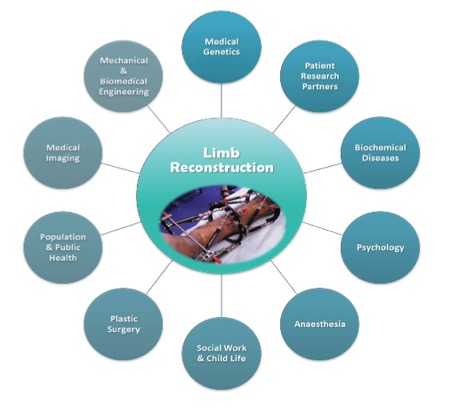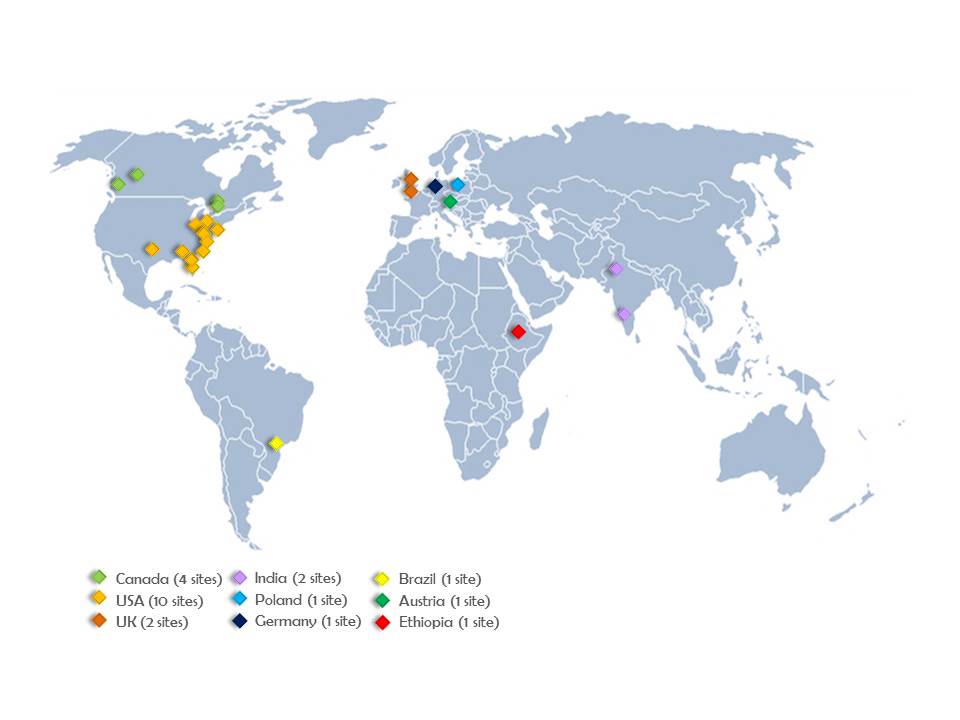RESEARCH VISION
Our vision is to establish a world-class limb lengthening and reconstruction program at BC Children’s Hospital (BCCH) in order to treat children with limb deformity with the best level of care available. We aim to maximize patient engagement to identify and address their needs and actively involve them as research partners. Our aim is to work directly with patients and families to answer clinical and research questions that matter to patients.
RESEARCH SUMMARY
Paediatric limb deformity represents a wide spectrum of devastating disorders affecting children. These include birth defects, the complications of severe infection in infancy and the late effects of trauma. Our multidisciplinary research program involves studies on quality of life, clinical outcomes, complications of limb reconstruction, and imaging in these patients.
INTERDISCIPLINARY COLLABORATIONS
BC Children’s Hospital is the highest volume pediatric limb deformity centre in Canada. We have been able to successfully create a multidisciplinary research program involving collaborations with Medical Genetics, Biochemical Diseases, Mechanical Engineering, Biomedical Engineering, Anaesthesia, Plastic Surgery, Medical Imaging, Bone Biology, Psychology, and Population and Public Health at hospitals and universities across Australia, Canada, Brazil, Ethiopia, India, Netherlands, Poland, Austria, Germany, UK, and USA.
INTERNATIONAL COLLABORATIONS
Our program has ongoing collaborations with various hospitals and universities across Australia, Canada, Ethiopia, India, Netherlands, UK, and USA. The international collaborations built through our program will not only influence clinical and research practices at each of the participating institutes but also catalyze new partnerships and contribute to BCCH’s status as a centre for clinical and research excellence.
MAIN RESEARCH PROJECTS
Quality of life (QOL) of children with lower limb deformities
Through this study we are investigating the impact of having a lower limb deformity on the QOL of children and adolescents. With our existing international collaborations, we were able to interview the children and families at various institutes in Canada, Ethiopia, India and USA and gain first-hand knowledge about the impact of having a lower limb deformity on the QOL of children. The international multicentre approach for this project has put us in a unique position to compare and contrast the differences/similarities in the QOL of children from various high income and lower - middle-income countries.
Limb-Q Kids Patient Reported Outcome Questionnaire
A new patient reported outcome measure establishing a way to measure the quality of life of 79 children thus far; specifically living with limb deformities. International collaboration across various sites from Canada, USA, India, and Ethiopia provided a unique opportunity to capture what matters most to children with lower limb differences.
Pediatric Elbow Fractures – From a Child’s View Point
This study looks at elbow fractures, which one of the most common fractures sustained following a fall on an outstretched hand among healthy children. This study involves interviewing children with elbow fractures and obtaining measurements of the play structure involved in the injury. These measurements when compared to the standards issued for children’s play spaces and equipment by the Canadian Standards Association (CSA) will have implications for the child safety and injury prevention.
Limb Deformity Database
Our limb deformity database, which has over 290 patients to date, allows us to prospectively record outcomes of various treatment procedures for children with limb deformities. This study will enable us to compare time in corrective frames, number of surgeries, and complications and help us determine any changes required in our ongoing clinical care based.
International Multicentre Pin Site Infection Study
Pin site infections have been the most commonly reported complication of external fixator devices used to treat a vast majority of limb differences. Our multicentre pin site infection study aims to measure and document pin site infection rate and pin site care across Canada, US and UK through a multicenter pin site infection database housed at BCCH. This study is documenting the factors affecting the rate of pin site infections across participating surgical practices and will potentially help in identifying factors leading to pin site infections. We have 12 participating centres across Canada, USA and the United Kingdom with 116 participants enrolled. This is the largest collaboration of its kind with 14-limb reconstruction surgeons around the world.
International Congenital Pseudarthrosis of the Tibia (CPT) Registry
CPT is a rare orthopaedic condition in which treatment must be closely monitored. The establishment of the ILDN has allowed more data to be collected with greater perspectives on a rare condition that would be difficult to study as an isolated site. Using the information, the registry aims to help clear up prominent controversies in CPT management. Additionally, it can help answer research questions surrounding treatment risks and the involved factors.
Observational Study of Children with Limb Deformities/Limb Deformity Database
There are many projects that can stem from the large dataset that is the Limb Deformity Database above. Using the data, the trajectory of treatment of congenital and acquired limb deformities can be compared for 291 patients. There is specific time points of interest throughout each patient’s treatment including baseline first visit, pre-operation, surgery, frame application, frame removal, and pin site infection. Information collected are quality of life assessments, functional assessments, and pain assessments. This study also bleeds into its branch project; QOL above.
Natural History Study of Morquio B Disease
Morquio B Disease (MBD) is a rare genetic disorder with less than 50 patients known worldwide. Together with international experts in MBD and patient partners, Dr. Sylvia Stockler (Head Division Biochemical Diseases, BCCH) and Dr. Cooper (Pediatric Limb Reconstruction surgeon) are conducting a prospective observational natural history study to determine measurable outcomes for the anticipated clinical trial of small chaperone molecule as a potential causative treatment for patients with MBD.
Post-Operative Pain in Children Undergoing Limb Reconstruction
POPS is the terms for Preventative Multimodal Analgesia for Children Undergoing Lower Limb Reconstruction with External Fixators: A Prospective Study of Post-Operative Pain. This study aims to reduce post-operative pain in children under going limb reconstruction surgeries using a combination of multiple anaesthesia medications. Questionnaires for pain management, pain scores, and mobilization ability will be administered to patients aged 5 - 18 years undergoing lower limb reconstruction with an external fixator. The collected data will help determine whether IV lidocaine infusion during the operation reduces post-operative pain and morphine consumption, and is associated with earlier mobilization and discharge from the hospital.
Standing MRI in children with Legg-Calve Perthes Disease (LCPD)
We have initiated a novel study to investigate the utility of standing MRI scans of hips affected by LCPD in children. The Centre for Hip Health and Mobility has the only research-dedicated upright MRI scanner of its kind in the world. The preliminary findings demonstrate the feasibility of upright MRI scanning and may reveal previously undetected hip deformities.
Next Generation Sequencing in Rare Orthopaedic Conditions
Along with the Departments of Medical Genetics and Biochemical Diseases, we are investigating the genetic causes of some rare orthopaedic problems. This work involves Next generation sequencing, which allows a person’s genes or entire genome to be read and analyzed within a few days. NGS allows the discovery of disease-causing genes with a relatively small number of patients.
Waiting Room Facilitation
The aim of this project is to support the families in the orthopaedic clinic waiting room and investigate the reason for long wait times. Long wait times have been shown to be a significant source of anxiety and unhappiness in families receiving care at the orthopaedic clinic at BC Children’s Hospital.
Measuring What Children Like or Dislike About Their Prothesis
The aim of this project is to develop a patient-reported outcome measure to assess satisfaction with prostheses in children with amputations and limb differences.








